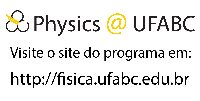Banca de QUALIFICAÇÃO: CAMILA PEREIRA RAMOS
Uma banca de QUALIFICAÇÃO de DOUTORADO foi cadastrada pelo programa.STUDENT : CAMILA PEREIRA RAMOS
DATE: 17/03/2025
TIME: 14:00
LOCAL: Sala 306 do Bloco B do Campus de Santo André da Universidade Federal do ABC
TITLE:
Exploring Dark Matter Simplified Models at the Large Hadron Collider
PAGES: 48
BIG AREA: Ciências Exatas e da Terra
AREA: Física
SUBÁREA: Física das Partículas Elementares e Campos
SPECIALTY: Reações Específicas e Fenomiologia de Partículas
SUMMARY:
The existence of dark matter (DM) has been widely supported by a plethora of documented evidences, but this new type of non-baryonic matter is yet to be observed. The efforts to detect it or a least understand its nature is divided into three fronts: direct
detection, indirect detection, and collider searches. However, it is not only necessary to have an experimental method but also to test the data obtained from it against a theory that encompasses DM. This can be a very complex task once there is a very large
number of new theories that fulfil this condition. Therefore, a good start would be to make the most general assumptions about DM as one possibly can. This work then explores a class of theories called simplified DM models in the context of collider searches, or more specifically, the Large Hadron Collider (LHC). The simplified models introduce a minimal number of parameters while providing a reasonable phenomenological description of interactions between the visible and dark sector. The DM production via both s-channel and t-channel mediator exchanges is analyzed, considering searches involving missing transverse energy with energetic jets in the final state as means of probing DM at colliders. Another extension to the standard model, involving two particles that mediate DM is presented as a step between the simplified scenarios and complete theories that contain a DM candidate.
COMMITTEE MEMBERS:
Presidente - Interno ao Programa - 1676798 - CELSO CHIKAHIRO NISHI
Membro Titular - Examinador(a) Interno ao Programa - 3057567 - CHEE SHENG FONG
Membro Titular - Examinador(a) Interno ao Programa - 1780373 - LAURA PAULUCCI MARINHO
Membro Suplente - Examinador(a) Interno ao Programa - 1676343 - PEDRO GALLI MERCADANTE




